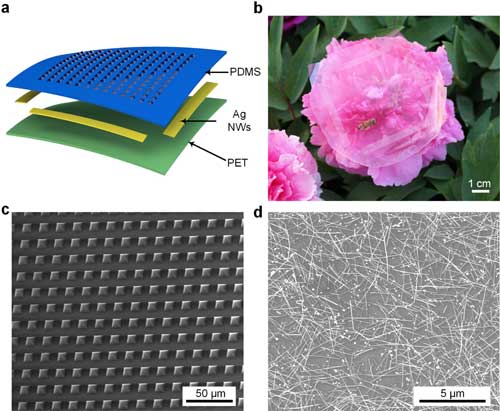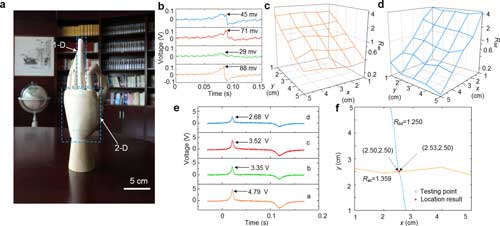| Posted: Apr 08, 2016 | |
An analogue smart skin that is self-powered |
|
| (Nanowerk Spotlight) In order to make robots and robotic technology more human-like and more human-friendly, smart skin technology is a critical element that helps robots sense the world. These electronic or smart skins could help machines to accurately perceive their environment and better assist human owners. | |
| However, conventional smart skins – no matter if they are based on resistance, capacitance or transistors – all need a power supply. It's kind of awkward for users to have a high-tech, state-of-the-art thin, flexible and light-weight smart skin and have to power it with a hard and heavy battery which can just work for hours. | |
| Furthermore, in conventional smart skins higher resolution always means higher energy consumption and complex circuits. These two aspects need to be carefully balanced to result in a practical device. So the obvious question is: Is it possible to achieve higher resolution and at the same time reduce energy consumption? | |
| A self-powered smart skin as the one just recently developed by a team of Chinese researchers fundamentally solves this problem. In this work, the scientists combine the triboelectric effect and planar electrostatic induction and apply it in a subtle device structure for the first time to create a self-powered analogue smart skin. | |
 |
|
| Structure of analogue smart skins. (a) Schematic diagram of an analogue smart skin. (b) Optical image of the transparent, flexible, and lightweight smart skin. The smart skin with a honey bee landing on it will not deform the peony. (c) SEM image of microstructures on the PDMS film. (d) SEM image of the silver nanowire electrodes. (Reprinted with permission by American Chemical Society) | |
| Reporting their findings in ACS Nano ("Self-Powered Analogue Smart Skin"), a team led by Prof. Haixia Zhang at the National Key Laboratory of Science and Technology on Micro/Nano Fabrication, Peking University, presents a self-powered analogue smart skin to detect location as well as contact velocity, based on a single-electrode contact electrification effect and planar electrostatic induction. | |
| In this paper, the team presents two significant achievements. The first is that their smart skin is intrinsically self-powered. | |
| "We use spontaneous triboelectric charges, combined with planar electrostatic induction, to sense the touch applied on the smart skin," Zhang explains to Nanowerk. "Triboelectric charges occur in our daily life everywhere when two surfaces touch each other. And when the charged surface approaches a metal block (or electrode) it will induce the opposite charge, which is the so-called 'electrostatic induction' effect." | |
| The beauty of this approach is that it makes use of the charges from the triboelectric effect – which exists everywhere. Imagine a scenario when you want to drink some coffee: you walk towards a table, and by doing so the opposite charges will be generated on the surface of shoes and ground respectively; you pick up the cup to drink, and the opposite charges will be generated on the skin of your palm and the handle of the cup; furthermore, even swallowing the coffee will generate charges on the surface of your digestive tract and the coffee. | |
| The Chinese researchers utilize these spontaneous – but often ignored – charges to make their smart skin completely self-powered. | |
| The intensity of the electrostatic induction effect depends on the distance between the charged surface and the metal electrode. The scientists use fixed electrodes to detect the intensity of the electrostatic induction effect, allowing them to confirm the location based on the relative intensity. | |
| That way, no extra power supply is required for operating the analogue smart skin. | |
| The second achievement is that only four electrodes are necessary to achieve millimeter bi-dimensional resolution (precision) because of the utilization of analogue localizing method to sense the touch stimulation. | |
| "Compared with previous works (see references 1-3 below), this smart skin reduces the number of electrodes remarkably," Zhang points out. "This helps a lot to reduce the complexity of the signal processing circuit. Although using less electrodes, our smart skins achieve 1.9 mm resolution, much better than previous results." | |
| She notes that, compared with digital smart skins which have been studied extensively, analogue smart skins still need more in-depth study. | |
| "Analogue smart skins have obvious advantages at resolution and energy consumption," she says. "I hope our work can draw more attention to the field of analogue smart skins. Furthermore, it will contribute to the areas of artificial intelligence and portable electronics as the self-powered high-resolution sensor offers a solution for smart skin applications." | |
 |
|
| Use of smart skin on an artificial hand. (a) Photograph of an artificial hand covered by two-dimensional analogue smart skins on the curved back of the hand and one-dimensional analogue smart skins on the middle finger. (b) Voltage output when a honey bee approaches and leaves the two-dimensional smart skin swiftly. (c,d) Voltage ratios of electrodes a-d. (e) Voltage output when the two-dimensional smart skin on the artificial hand is touched. (f) Location result of analogue smart skins. The testing point is (2.50, 2.50), and the result is (2.53, 2.50), with a slight deviation of only 0.3 mm. (Reprinted with permission by American Chemical Society) (click on image to enlarge) | |
| Going forward, the team will work on the stretchability of their smart skin (the current version is not stretchable) and on improving the resolution. According to the team, due to the theoretically infinite resolution, there still is plenty of room to improve on the current performance. Furthermore, they will try to integrate more sensing parameters as well as signal transmission in the design. | |
| Last but not least, they will explore approaches to shield the smart skin from environmental interference, which is critical for practical applications. | |
| Zhang notes that the current device design provides opportunities for including additional sensing capabilities such as temperature, contact velocity, or gas composition. | |
| References | |
| 1) Takao Someya's Group,36 electrodes for 64 square centimeter smart skins. Kaltenbrunner, M, et al. "An ultra-lightweight design for imperceptible plastic electronics." Nature 499.499(2013):458-63. | |
| 2) Zhenan Bao?s Group, 16 electrodes for 4 square centimeter smart skins. Lipomi, Darren J., et al. "Skin-like pressure and strain sensors based on transparent elastic films of carbon nanotubes." Nature Nanotechnology 6.12(2011):788-792. | |
| 3) Do Hwan Kim's Group, 14 electrodes for 16 square centimeter smart skins. Kim, So Young, et al. "Highly Sensitive and Multimodal All-Carbon Skin Sensors Capable of Simultaneously Detecting Tactile and Biological Stimuli." Advanced Materials 27.28(2015):4178-4185. | |
 By
Michael
Berger
– Michael is author of three books by the Royal Society of Chemistry:
Nano-Society: Pushing the Boundaries of Technology,
Nanotechnology: The Future is Tiny, and
Nanoengineering: The Skills and Tools Making Technology Invisible
Copyright ©
Nanowerk LLC
By
Michael
Berger
– Michael is author of three books by the Royal Society of Chemistry:
Nano-Society: Pushing the Boundaries of Technology,
Nanotechnology: The Future is Tiny, and
Nanoengineering: The Skills and Tools Making Technology Invisible
Copyright ©
Nanowerk LLC
|
|
|
Become a Spotlight guest author! Join our large and growing group of guest contributors. Have you just published a scientific paper or have other exciting developments to share with the nanotechnology community? Here is how to publish on nanowerk.com. |
|
